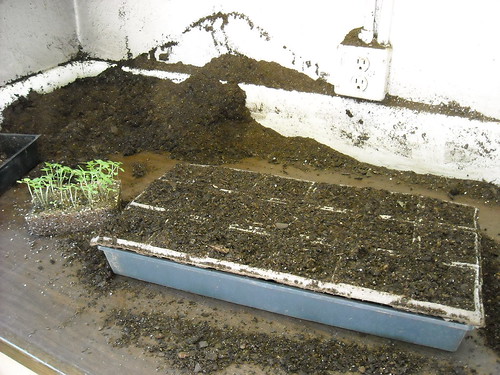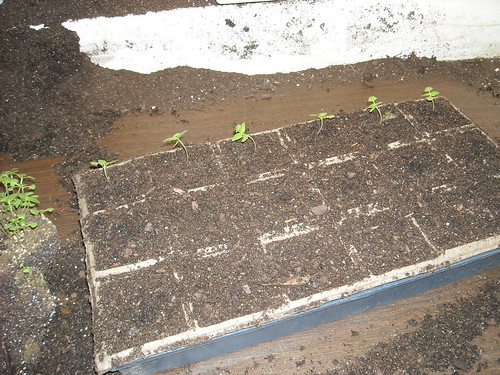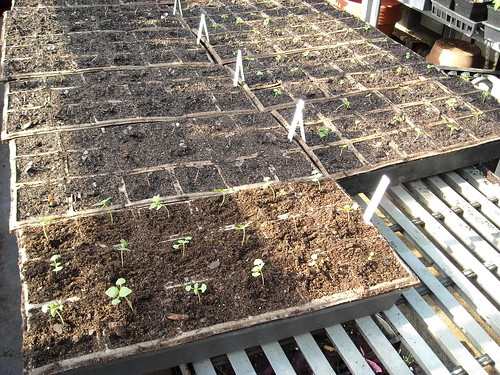A dear friend and fellow gardener just gave me an awesome book for my birthday,
The Brother Gardeners: Botany, Empire & the Birth of an Obsession by Andrea Wulf. It’s all about the “small group of eighteenth-century naturalists who made Britain a nation of gardeners and the epicenter of horticultural and botanical expertise.” Ironically, many of the new plants these adventurous naturalists exploited for their (and now our) gardens came from America. I’d be willing to bet my grandma’s Fuchsias that some of those plants came from the brothers Pierce who collected the trees and planted the arboretum that was destined to become Longwood Gardens.
In another ironic twist, the Museum of Garden History in Lambeth, England - also known as St. Mary's Churchyard - is the final resting place of the John Tradescants, father and son plant hunters, along with William Bligh, he of the ill-fated HMS Bounty (all that drama over a little plant called
Artocarpus altilis. Tsk, tsk).
Flipping through my new library addition, I was reminded of a coffee table book of tropical plants my dad received while he lived in Hawaii. The breadfruit tree was, of course, one of the plants profiled along with an account of the historic mutiny. What intrigued me even more was the mention of a botanist on board the previous Bounty voyage whose surname is the same as mine. I have no idea if this botanist was an ancestor but given that no one else in my immediate family has the Plant Geek Gene to the extent that I have, it made me wonder if the botanical predisposition for green fingers could indeed have been passed down through the generations. Things that make you go, “Hmmmmm…”
Stories of plant hunters’ adventures have always fascinated me, like the tales of Scottish botanist David Douglas (who happens to share my mother’s maiden name. Hmmmm….). This guy, for whom the Douglas Fir is named and who kindly introduced the California Poppy to the world, traveled to the wilds of the American West, the Sandwich Islands, and islands of Hawaii looking for plants. He surmounted inhospitable terrain, survived plagues, pestilence, thieves, and attacks by ill-tempered Indians only to tumble to his death at the bottom of a pit dug to trap wild bulls. He was 35. These plant hunters were serious about plants and many of them died in their quests to bring us the flowers, trees, and shrubs that now adorn our landscapes.
In a small way, I got a taste of what it might have been like to be a plant hunter when, one fine spring day, I was dropped in the middle of the woods with a bucket and a trowel. My mission was to search for native Trilliums (
Trillium cernuum L.) that were in the path of the proposed relocation of Route 52. The Trilliums had to be moved to another forested area within the gardens, there to live long and prosper (when I e-mailed a friend about my adventure, he said Trillium sounded like some rare element that the crew of the Enterprise would look for on a distant, deserted planet, only to be attacked by the "Keeper of the Trillium" who is in reality a really nice alien computer. You really have to be up on your 60’s and 80’s space adventures to get that one).
The satellite image below shows my approximate location within Longwood's 1,050 acres:

Pardon the crayon, but it's the best I could do on short notice. The blue arrow is roughly where I worked that day and it looked something like this:

No wild bull pits, nor wild bulls, but there were other dangers to beware. What made this particular plant hunting excursion challenging was that the Jack-in-the-Pulpits (
Arisaema triphyllum) were also out and look similar enough to my objective that finding the Trillium was tricky indeed. Luckily, many of the
Arisaema were in bloom, which made my job a bit easier.
And thus it was that I had to be able to tell the difference between this and this:

But perhaps more importantly, the difference between this and this:

Three guesses what they are!? And wouldn't you know, both of them were EVERYWHERE!! Now, I've never had the opportunity to enjoy the afterglow of an encounter with Toxicodendron radicans, mostly because there isn't any poison ivy in the concrete jungle of LA (though there is poison oak, which I apparently never came in contact with either) and I really wasn't all that eager to make it an intimate acquaintance, if you get my drift. But part of being an Intrepid Plant Hunter is that you must actually advance through the forest in search of that which you seek. That means your boots and the hems of your jeans will trod on and brush against these two plants, one of which could really make life miserable!
And you think being marooned on a boat in your pajamas is bad.
I decided to cowboy-up (thank goodness for Tecnu) and in the end I did find a few Trilliums, dug them carefully and put them in my bucket then looked around to admire the majestic scenery and realized with a growing sense of excitement that I really had no idea where in the bloody forest I was. Panic did not ensue because my supervisor was coming back to get me, but can you imagine trekking through new and uncharted territory with potentially hostile natives as your guide? Far enough away from signs of civilization and the state highway, hearing nothing but the mysterious forest sounds around me, I sure could. There is a theory that poor David Douglas was pushed into that pit, you know, so I admit to a sigh of relief when I heard the rumble of the Kubota’s engine on the path signaling lunchtime.
I still wonder if this venturesome spirit is handed down through the gene pool because obviously not everyone would relish a day stranded in the woods. It must, I think, because another dear friend and fellow horticulturist sent me another book, the Eyewitness Travel Guide to Philadelphia, which means more adventures!
On that trip, at least, I'll remember to take my towel*.
*For an explanation, please refer to the thrilling Sci-Fi best seller The Hitchhiker’s Guide to the Galaxy.
 Mr. Groundhog pops up to say hello.
Mr. Groundhog pops up to say hello.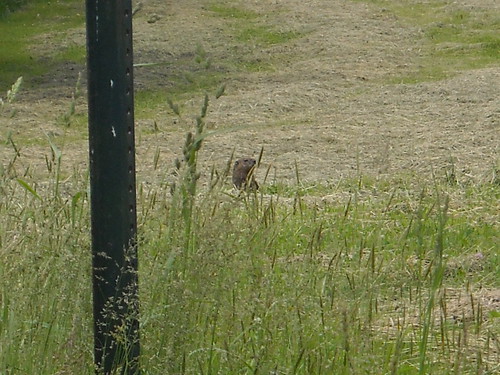 A misty morning at Webb Barn. Quite often deer would venture out of the woods and one morning we watched a pair of foxes romping in the grass.
A misty morning at Webb Barn. Quite often deer would venture out of the woods and one morning we watched a pair of foxes romping in the grass. The water tower at The Row seen from Abbondi (so called because that was the name of the family who previously owned the land), one of the areas of managed wetlands.
The water tower at The Row seen from Abbondi (so called because that was the name of the family who previously owned the land), one of the areas of managed wetlands.

 Unclogging the drainage pipe in one of the ponds (no thanks to Mr. Beaver) created this whirlpool about the size of a dinner plate.
Unclogging the drainage pipe in one of the ponds (no thanks to Mr. Beaver) created this whirlpool about the size of a dinner plate. .JPG)
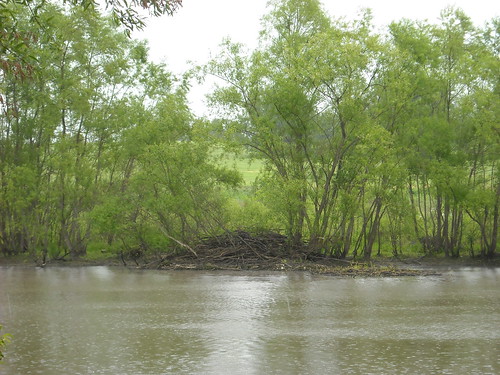 Once the pond drained a bit we rigged up The Beaver Deceiver!
Once the pond drained a bit we rigged up The Beaver Deceiver!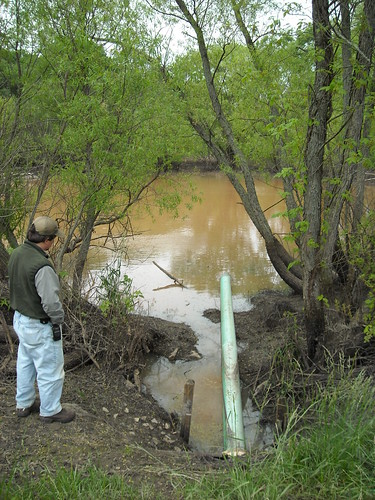
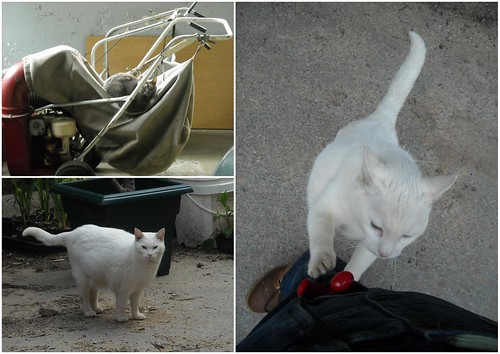
 And this...
And this... But worst of all, this...
But worst of all, this... Immediately I was on my knees, craning my neck to peer under the leaves in search of the ne'er-do-well that was making a feast out of my garden and I found it! Or should I say THEM!!!
Immediately I was on my knees, craning my neck to peer under the leaves in search of the ne'er-do-well that was making a feast out of my garden and I found it! Or should I say THEM!!! Striped Cucumber Beetles, ravaging my zucchini!!! I ran, not walked, into the potting shed, grabbed a couple of sticky cards, and began turning over every leaf. On half a dozen seedlings I caught twice as many beetles! Just look for yourself!!
Striped Cucumber Beetles, ravaging my zucchini!!! I ran, not walked, into the potting shed, grabbed a couple of sticky cards, and began turning over every leaf. On half a dozen seedlings I caught twice as many beetles! Just look for yourself!! It was only then that I realized the awful truth - my garden's been besieged! To make matters even worse, these little beetles have super-beetle powers and are immune to the sticky on sticky cards! Darn if those little buggers skated right off like they were rollerblading on butter!
It was only then that I realized the awful truth - my garden's been besieged! To make matters even worse, these little beetles have super-beetle powers and are immune to the sticky on sticky cards! Darn if those little buggers skated right off like they were rollerblading on butter!



 I did manage to weed, compost, and top dress the Summer Squash patch, the small beds around the raised planter, and the two tomato beds. In keeping with my companion planting experiments, the tomatoes are sharing their beds with more onions, garlic, shallots, parsley, and marigolds. And if you think that's suggestive you should read what they said about Linnaeus and his ideas. So far, I've had little to no insect damage to my crops, so there must be something to the companion theory!
I did manage to weed, compost, and top dress the Summer Squash patch, the small beds around the raised planter, and the two tomato beds. In keeping with my companion planting experiments, the tomatoes are sharing their beds with more onions, garlic, shallots, parsley, and marigolds. And if you think that's suggestive you should read what they said about Linnaeus and his ideas. So far, I've had little to no insect damage to my crops, so there must be something to the companion theory! I planted 10 Zucchini 'Black Beauty' seeds and another 10 the following week for a successional harvest. On the trellis on the edge of the zucchini bed I planted Snow Peas. I even made good on my threat to add a pink flamingo!
I planted 10 Zucchini 'Black Beauty' seeds and another 10 the following week for a successional harvest. On the trellis on the edge of the zucchini bed I planted Snow Peas. I even made good on my threat to add a pink flamingo!



 And I've got this large container to plant. I'm thinking a tall grass for height, a couple of container tomatoes, something spilly...decisions, decisions.
And I've got this large container to plant. I'm thinking a tall grass for height, a couple of container tomatoes, something spilly...decisions, decisions. It's still very much a work in progress so stay tuned for more exciting developments. And if you'd like to see it yourself, bring a fork. I'll put you to work pulling thistle!
It's still very much a work in progress so stay tuned for more exciting developments. And if you'd like to see it yourself, bring a fork. I'll put you to work pulling thistle!
 No wild bull pits, nor wild bulls, but there were other dangers to beware. What made this particular plant hunting excursion challenging was that the Jack-in-the-Pulpits (Arisaema triphyllum) were also out and look similar enough to my objective that finding the Trillium was tricky indeed. Luckily, many of the Arisaema were in bloom, which made my job a bit easier.
No wild bull pits, nor wild bulls, but there were other dangers to beware. What made this particular plant hunting excursion challenging was that the Jack-in-the-Pulpits (Arisaema triphyllum) were also out and look similar enough to my objective that finding the Trillium was tricky indeed. Luckily, many of the Arisaema were in bloom, which made my job a bit easier. But perhaps more importantly, the difference between this and this:
But perhaps more importantly, the difference between this and this:

 Highly technical and precise. Don't get me started on the military operations that will encompass weed abatement.
Highly technical and precise. Don't get me started on the military operations that will encompass weed abatement.

